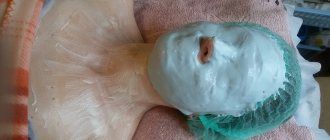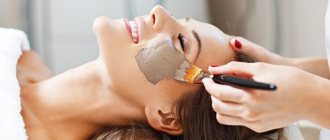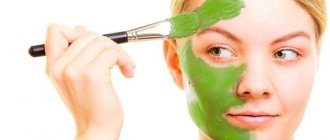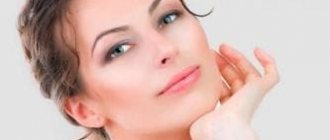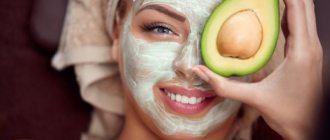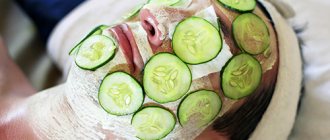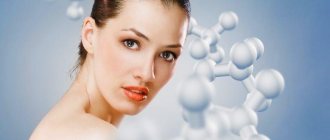Alginate face mask - its properties
The basis for alginate face mask is sodium alginate. It is obtained from brown algae through processing. This substance was discovered more than 50 years ago.
The discovery of this substance was almost accidental. An English scientist conducted research to obtain iodine from kelp. During the experiment, he isolated salts of alginate acid.
Since then, sodium alginate has firmly taken its place in cosmetology.
Alginic acid salt has unique properties:
- Absorbs water well, forming a gel-like mass that retains its properties at different temperatures
- Has excellent restorative properties
- Removes toxins and waste from the body
What is it for?
Alginate masks have universal compositions and are suitable for young, mature, and aging skin, solving many problems. In combination with other cosmetics that are selected individually, they significantly improve the quality of the outer skin. Thanks to their influence:
- skin tone improves: its elasticity and firmness;
- the structure is aligned by smoothing out small wrinkles;
- moisture is retained in the cells;
- the walls of the capillaries are strengthened;
- pores are cleaned and narrowed;
- the lifting effect is noticeable: sagging areas are tightened;
- subcutaneous fat deposits disappear and toxins are eliminated;
- a delicate “peach” skin tone appears.
Banana face mask
Masks are safe and hypoallergenic, their benefits are obvious, so they are widely used in cosmetology and are recognized by those who have experienced their effect on themselves. An algae-based mask also solves more serious problems and is used if:
- signs of aging and fading are noticeable;
- dryness appears as a consequence of water balance imbalance;
- pigmentation begins;
- spider veins are visible;
- signs of inflammation or peeling appear;
- post-acne or scars occur.
Alginate masks appeared on the cosmetics market relatively recently. Alginic acid in brown algae was discovered by the English chemist Moore Stanford when obtaining iodine. Why alginates were needed and whether they would be beneficial, he did not know. But later women appreciated this discovery.
Alginate mask and its use
Excellent moisture retention is one of the properties of an alginate face mask. That is why it is indispensable in the care of dry skin. In addition, it stimulates metabolic processes and increases skin turgor.
Not many mask compositions have such a pronounced tightening effect. For this reason, an alginate face mask is excellent for age-related contour correction. With its help you can tighten your skin at home. What results can you get using an alginate face mask?
- Even skin color
- Narrowing and cleansing pores
- Skin restoration
- Relieving swelling
- Hydration and nutrition
- Smoothing out wrinkles
- Contour modeling
- Removing toxins and other “garbage”
- Improved lymph circulation
Beneficial properties of alginates
The beneficial properties of seaweed for the human body were known back in Ancient China and India. However, alginic (algae) acid, the content of which in brown seaweed ranges from 13 to 54%, was accidentally discovered in 1981 by an Englishman engaged in iodine extraction. It is found in brown algae in the form of alginate salts. In terms of its beneficial properties, not a single plant on the surface of the earth can compete with this gift of nature to man - seaweed, which has become a source of alginates. Alginates contain vitamins A, B1, B2, B6, B9, C, PP, Beta-carotene; macroelements potassium, sodium, magnesium, magnesium, calcium; trace elements iodine, iron. They have properties unique to them: swelling, adsorption, viscosity and special interaction with various structures.
At first they were used in medicine for healing wounds, regenerating burns, bedsores, removing toxins and radionuclides from the body, stopping bleeding, etc. Then they began to be used in the food industry in the form of thickeners. Later, cosmetologists examined these salts and chose harmless sodium alginate. It is used mainly in the form of a light beige powder, which, when dissolved with clean water, produces a gel-like face with many beneficial nutrients, vitamins and minerals.
Alginate masks can be made in expensive prestigious salons (the price of a mask is from 400 hryvnia), you can buy ready-made masks in the form of powders (less often, gels), or you can prepare them yourself.
Alginate face mask - the result of use
The uniqueness of the composition of the alginate face mask also lies in the fact that additional components can be used under it. These additives, applied under a mask, only enhance their effect. It is good to introduce serum, oil, cream, hylauronic acid under an alginate mask.
An alginate face mask is used:
- As part of body wraps – reduces fat accumulation and removes cellulite
- With the addition of menthol - smoothes wrinkles, relaxes muscles and evens out the skin
- When using oils, it eliminates signs of fatigue and gives the skin radiance.
The use of alginate mask in home cosmetology
You can buy sodium alginate for the face at a pharmacy or cosmetics store. It is a white fine powder. When water is added, the powder turns into a gel. It is most often packaged in bags of different weights.
Sodium alginate salts have a very interesting effect:
- If the skin is dry, then an alginate face mask will moisturize it, make it soft and velvety.
- For oily skin, the mask normalizes the activity of the sebaceous glands.
- By affecting aging and aging skin, alginate stimulates regeneration and restoration.
The mask should be used no more than 2 times every 7 days. The effect will be better from a course of use: 2 months, and then a break.
Once applied to the face, the mask turns into a film, which must be removed from the bottom up. Even after using this mask once, your face will look fresh and rested.
Watching time: 01:33
How to dilute and how to apply cosmetic composition
An alginate cosmetic mask that you bought in a store and made yourself is diluted according to DIFFERENT rules. This must be taken into account. The cosmetic powder already contains white clay and you do not need to add any oils to the powder. How to breed.
- Pour 30-50 grams of powder into 100 ml. cold (this is important) water.
- Mix thoroughly, in a bowl you will get a thick mass that hardens very quickly.
- After you have mixed the powder, immediately apply the mask to your face along massage lines from top to bottom, including the neck area, eyes and lips.
- After 25-30 minutes, carefully remove the composition from the skin in the direction from bottom to top. After the procedure, be sure to moisturize your face with cream. For effective results, such procedures must be carried out in a course: 6-10 times, 1 to 3 times a week.
The mask hardens very quickly, forming a thick layer of elastic film on the face. At the same time, the composition tightens the facial muscles and removes puffiness.
Recommendations for application
It is not convenient to apply the mask yourself; after the layer is applied to the face, you need to lie down. Due to the fact that the mask quickly tightens, a very deep relaxation of the muscles occurs, facial wrinkles are smoothed out, and the oval of the face is tightened.
Before applying, you can moisturize your face with nourishing oil, it can also be hyaulorone serum, grape seed oil, if severe rosacea is observed, before applying the alginate mask, apply oil or St. John's wort extract to your face.
The active substances under the action of alginate will penetrate into the deep layers of the skin and you will receive an excellent lymphatic drainage massage , which can be compared with the use of hardware.
Alginate face mask - basic recipe
Components
The recipe for a basic mask at home includes the following ingredients:
- Sodium alginate powder (tablets are not suitable) – 3 g
- Water – 2 tbsp. l.
The alginate is filled with water to swell and turn into a gel.
- Cosmetic clay is taken in the amount of less than a tablespoon, i.e. 10 gr. The clay is mixed with water until it becomes a paste.
- In order for the mask to harden like rubber, you need 1 ampoule of calcium chloride. By the way, you can do without it: then the mask can simply be washed off with water. The added calcium chloride acts as a plasticizer.
How to do
Mix alginate gel with prepared clay and additives. The mixture should be homogeneous. Pour in calcium chloride (or without it).
Important: for the mask to work, the proportions of the ingredients must be equal. Only calcium chloride is always added in the amount of 1 ampoule.
The prepared composition hardens quickly: therefore, it must be applied to the face within 5–10 minutes.
Correct application of an alginate mask
- Before application, cleanse skin of makeup and impurities.
- Tuck your hair under the bandage
- Eyebrows need to be smeared with a thick cream so that the mass does not stick to them.
- It is recommended to apply the mask with a cosmetic spatula.
- Apply the mask in front of a mirror, or preferably while lying down. True, for this application option you will need an assistant.
- You need to start applying the mask from the neck up. This will enhance the lifting effect, since the mixture hardens and tightens the skin. The optimal layer thickness is about 3 mm. The composition hardens quickly enough, so you don’t need to apply it for a long time to make the mask work. With quick movements, it is necessary to distribute a layer of equal thickness over the skin: from 3 mm to 5 mm.
- The skin near the eyes can also be coated with the composition.
- 5 minutes after application to the skin, the edges of the mask can be lubricated with cream. This will make it easier to remove.
- Leave the mask on your face for optimally 30 – 40 minutes.
Contraindications and rules of use
Both in the salon and at home, an alginate mask is used and applied in approximately the same way. The method of application is a little more complicated due to rapid plasticization than with conventional masks. They have a small number of contraindications and require caution if you have certain diseases :
If psoriasis and dermatitis worsen, you should refrain from using masks.- Individual intolerance and allergy to the components of mixtures.
- For any cancer, the use of alginates is strictly prohibited.
- If you have conjunctivitis, the mask should not be applied to the area around the eyes.
- If you have cold symptoms such as cough and nasal congestion, leave the skin around your mouth and nose free.
- Owners of eyelash extensions should not apply the product to the skin around the eyes and eyelids.
The procedure for using alginate masks is as follows:
- Preparing the face. You need to remove makeup from the skin and treat it with lotion or tonic. To enhance the cosmetic effect of the procedure, you can apply a care product under the alginate mask. This can be any serum - with hyaluronic acid, vitamins or with a lifting effect. Treat eyebrows, eyelashes and the border with the scalp with a thick cream or Vaseline - this guarantees that part of the hair will not be removed along with the mask being removed. Instead of cream, you can apply castor oil to your eyelashes. It will not only protect the eyelashes, but will also promote their growth and strengthening.
- Preparing the mixture. Commercial alginate mixtures are available in either gel or powder form. Gel-like products should be applied to prepared skin immediately after opening the package. The powdered preparation is diluted with water (thermal or mineral without gas), achieving uniformity of the mass, without lumps. If you decide to make an alginate mask with your own hands, the procedure will be slightly different.
- Apply the finished mixture with a cosmetic spatula or spatula in a very thick layer on the face, neck and area around the eyes. It is easier to distribute the mass on the skin if you have an assistant. If you apply the mask yourself, then, while in front of the mirror, tilt your head back slightly, and immediately after application, take a horizontal position.
- The exposure time of the mask should be 20-30 minutes. If you're doing it without an assistant, set a timer so you don't miss out on time. Feelings of coldness, tightness, and slight numbness are normal. The mixture should feel like a rubber film on your face.
- Removing the plasticized mass. Correctly remove the frozen mixture in the direction from the neck to the forehead. You need to grab it by the bottom edge and pull it up sharply to remove it from the skin in one motion. The mask may come off in pieces and tear in your hands. In this case, carefully remove each piece, paying special attention to the border with the hair growth area, the area around the eyes and nasolabial folds. The remaining particles can only be thrown into the trash bin. Disposing through the drain will cause a clog.
- At the final stage, treat the skin with moisturizer.
Alginate face mask – additional components
As mentioned above, the effect of an alginate mask can be enhanced through additives. To saturate the skin with vitamins, you can distribute oil-based vitamins E and A over the skin. After this, apply the mask. It's also good to use:
- Cocoa butter – helps smooth out wrinkles and tone.
- Rose essential oil – for aging and aging skin.
- Tea tree oil - to enhance the anti-inflammatory effect of the mask. Great for acne and rashes.
- Argan oil - helps nourish, smooth out wrinkles, renew and protect skin cells.
- Chamomile infusion - to soothe skin with acne.
- Laminaria powder will make it possible to enhance lifting - the properties of alginate
- Shilajit - rejuvenate the skin, activate the production of its own collagen.
Recipes for the best masks with alginate
Before making masks with alginate and additives, you should conduct an allergy test.
Lifting effect: mask with hyaluronic acid
It will help cope with aging skin sagging, sagging, decreased tone and swelling. For her:
- Alginate – 2 tsp. pour 4 tbsp. l. water.
- Hylauronic acid – 10 drops, mix into the composition.
- Apply to face for 30 minutes.
- Remove the mask and apply nourishing cream.
Laminaria with alginate for mature skin
- Mix 5 grams of alginate powder with 3 tbsp. l. warm water, let it swell.
- Combine blue cosmetic clay with 1.5 tsp. dilute kelp powder with water: 3.5 tbsp. l.
- Combine both compositions together, bring the mixture to a homogeneous state and distribute over the skin.
Alginate with pearl powder
This mask will help prevent aging, make the skin tight and elastic.
- 2 grams of alginate pour 1.5 tbsp. l. water and stir.
- Separately, combine 6 grams of pearl powder with 6 grams of clay and mix with 1.5 tbsp. l. water.
- Bring alginate gel and pearl-clay mixture to a homogeneous state.
- Apply to face.
Botox – alginate acid mask
The effect of instant tightening will be given by a mask that contains:
- Prepare the gel base - 5 grams of alginate diluted with 3 tbsp. l. water
- 1.3 tbsp. l. Mix wheat flour with calendula decoction until you get a paste.
- Stir a partial cupful into the flour mixture. l. grape seed oil.
- Combine the two mixtures, mix and add an ampoule of calcium chloride for plasticization.
- Mix again and spread over the face.
What are alginates
Alginates are salts of alginic acid, which are found mainly in red, brown and some green algae. This substance has very high hygroscopicity and is therefore used in the food industry as a thickener. Since its chemical composition is a polymer of uronic acids, which include, in particular, hyaluronic acid, the use of its compounds in cosmetology is primarily due to the ability to moisturize the skin. In addition, both alginic acid itself and its salts are capable of binding toxic substances and heavy metals, forming complex insoluble conglomerates with them.
The source of alginates for the cosmetic industry is seaweed
According to their physical properties, alginates in water form colloidal solutions, which, when interacting with calcium ions, form insoluble gels. Thanks to this property, alginate masks form a homogeneous film on the face, which, after drying, is completely removed without requiring rinsing.
